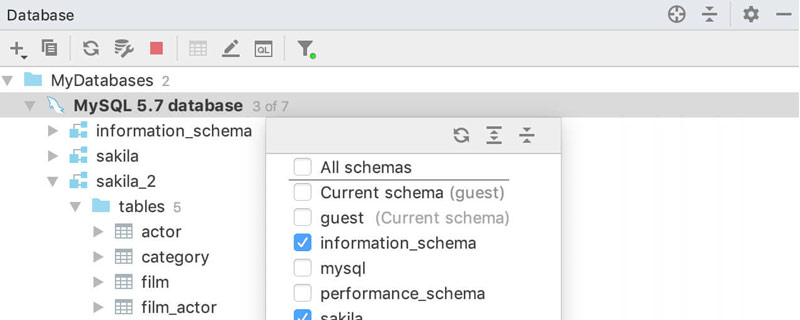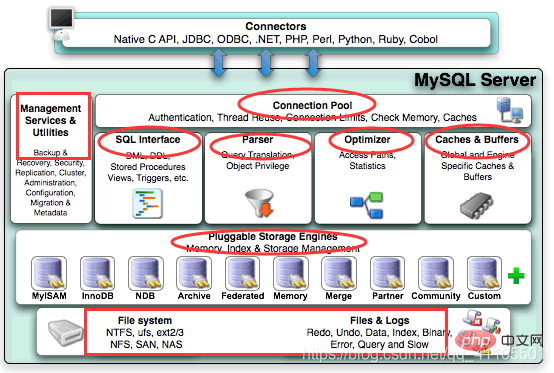Detailed explanation of the overall structure of MySql

The overall structure of MySql
MySQL consists of connection pool, SQL interface, parser, optimizer, cache, storage Engine, etc., can be divided into three layers, namely the MySQL Server layer, the storage engine layer and the file system layer. The MySQL Server layer includes the connection layer and the SQL layer. The following is the infrastructure diagram of MySQL in the official documentation:

#In the above figure, Connection pool is the connection layer, Management Services & Utilities...Caches & Buffers is the SQL layer, and Pluggable Storage Engines is the storage engine layer, and File system, Files & Logs are the file system layer.
Connectors do not belong to any of the above layers. Connectors can be understood as various clients and application services, mainly referring to the interaction between different languages and SQL.
Related free learning recommendations: mysql video tutorial
1. Connection layer
The application connects to MySQL through interfaces (such as ODBC, JDBC), and the first connection processing is the connection layer. The connection layer includes three parts: communication protocol, thread processing, and user name and password authentication.
- The communication protocol is responsible for detecting whether the client version is compatible with the MySQL server.
-Thread processing means that each connection request will be assigned a corresponding thread, which is equivalent to one SQL corresponding to one thread, one thread corresponding to one logical CPU, and switching between multiple logical CPUs.
- Password authentication is used to verify whether the account, password and host authorization created by the user can connect to the MySQL server.
Connection Pool belongs to the connection layer. Since it takes a lot of time to establish a connection every time, the role of the connection pool is to cache user connections, user names, passwords, permission verification, thread processing and other needs that need to be cached. Next time, you can directly use the established connection. Improve server performance.
2. SQL layer
The SQL layer is the core of MySQL, and MySQL’s core services are implemented in this layer. It mainly includes permission judgment, query cache, parser, preprocessing, query optimizer, cache and execution plan.
- Permission judgment can check whether the user has permission to access a certain library, a certain table, or a certain row of data in the table.
- The query cache operates through the Query Cache. If the data is in the Query Cache, the results are returned directly to the client without the need for query parsing, optimization, and execution.
- The query parser parses the SQL statement to determine whether the syntax is correct.
- The preprocessor processes semantics that the parser cannot parse.
- The query optimizer rewrites and optimizes the SQL accordingly, and generates the optimal execution plan. Then it can call the API interface of the program and access the data through the storage engine layer.
Management Services & Utilities, SQL Interface, Parser, Optimizer, and Caches & Buffers belong to the SQL layer, as detailed in the following table.
| Name | Description |
|---|---|
| ## System management and control tools for #MySQL, including backup and recovery, MySQL replication, clustering, and more. | |
| is used to receive the user's SQL command and return the results that the user needs to query. For example, SELECT FROM calls the SQL Interface. | |
| When the SQL command is passed to the parser, it will be verified and parsed by the parser so that the MySQL optimizer can recognize the data structure Or return an error for the SQL statement. | |
| The SQL statement will use the query optimizer to optimize the query before querying, and at the same time verify whether the user has permission to query, and the cache Is the latest data available? It uses a "select-project-join" strategy for querying. For example, | SELECT id, name FROM student WHERE gender = "female"; In the statement, the SELECT query first selects based on the WHERE statement, instead of querying the entire table and then filtering by gender. The SELECT query first performs attribute projection based on id and name, instead of extracting all attributes and then filtering, and connects these two query conditions to generate the final query result. |
| If the query cache has a hit query result, the query statement can directly fetch data from the query cache. This caching mechanism is composed of a series of small caches, such as table cache, record cache, key cache, permission cache, etc. |
The above is the detailed content of Detailed explanation of the overall structure of MySql. For more information, please follow other related articles on the PHP Chinese website!

Hot AI Tools

Undresser.AI Undress
AI-powered app for creating realistic nude photos

AI Clothes Remover
Online AI tool for removing clothes from photos.

Undress AI Tool
Undress images for free

Clothoff.io
AI clothes remover

Video Face Swap
Swap faces in any video effortlessly with our completely free AI face swap tool!

Hot Article

Hot Tools

Notepad++7.3.1
Easy-to-use and free code editor

SublimeText3 Chinese version
Chinese version, very easy to use

Zend Studio 13.0.1
Powerful PHP integrated development environment

Dreamweaver CS6
Visual web development tools

SublimeText3 Mac version
God-level code editing software (SublimeText3)

Hot Topics
 MySQL's Role: Databases in Web Applications
Apr 17, 2025 am 12:23 AM
MySQL's Role: Databases in Web Applications
Apr 17, 2025 am 12:23 AM
The main role of MySQL in web applications is to store and manage data. 1.MySQL efficiently processes user information, product catalogs, transaction records and other data. 2. Through SQL query, developers can extract information from the database to generate dynamic content. 3.MySQL works based on the client-server model to ensure acceptable query speed.
 How to start mysql by docker
Apr 15, 2025 pm 12:09 PM
How to start mysql by docker
Apr 15, 2025 pm 12:09 PM
The process of starting MySQL in Docker consists of the following steps: Pull the MySQL image to create and start the container, set the root user password, and map the port verification connection Create the database and the user grants all permissions to the database
 Laravel Introduction Example
Apr 18, 2025 pm 12:45 PM
Laravel Introduction Example
Apr 18, 2025 pm 12:45 PM
Laravel is a PHP framework for easy building of web applications. It provides a range of powerful features including: Installation: Install the Laravel CLI globally with Composer and create applications in the project directory. Routing: Define the relationship between the URL and the handler in routes/web.php. View: Create a view in resources/views to render the application's interface. Database Integration: Provides out-of-the-box integration with databases such as MySQL and uses migration to create and modify tables. Model and Controller: The model represents the database entity and the controller processes HTTP requests.
 Solve database connection problem: a practical case of using minii/db library
Apr 18, 2025 am 07:09 AM
Solve database connection problem: a practical case of using minii/db library
Apr 18, 2025 am 07:09 AM
I encountered a tricky problem when developing a small application: the need to quickly integrate a lightweight database operation library. After trying multiple libraries, I found that they either have too much functionality or are not very compatible. Eventually, I found minii/db, a simplified version based on Yii2 that solved my problem perfectly.
 How to install mysql in centos7
Apr 14, 2025 pm 08:30 PM
How to install mysql in centos7
Apr 14, 2025 pm 08:30 PM
The key to installing MySQL elegantly is to add the official MySQL repository. The specific steps are as follows: Download the MySQL official GPG key to prevent phishing attacks. Add MySQL repository file: rpm -Uvh https://dev.mysql.com/get/mysql80-community-release-el7-3.noarch.rpm Update yum repository cache: yum update installation MySQL: yum install mysql-server startup MySQL service: systemctl start mysqld set up booting
 Centos install mysql
Apr 14, 2025 pm 08:09 PM
Centos install mysql
Apr 14, 2025 pm 08:09 PM
Installing MySQL on CentOS involves the following steps: Adding the appropriate MySQL yum source. Execute the yum install mysql-server command to install the MySQL server. Use the mysql_secure_installation command to make security settings, such as setting the root user password. Customize the MySQL configuration file as needed. Tune MySQL parameters and optimize databases for performance.
 Laravel framework installation method
Apr 18, 2025 pm 12:54 PM
Laravel framework installation method
Apr 18, 2025 pm 12:54 PM
Article summary: This article provides detailed step-by-step instructions to guide readers on how to easily install the Laravel framework. Laravel is a powerful PHP framework that speeds up the development process of web applications. This tutorial covers the installation process from system requirements to configuring databases and setting up routing. By following these steps, readers can quickly and efficiently lay a solid foundation for their Laravel project.
 MySQL vs. Other Programming Languages: A Comparison
Apr 19, 2025 am 12:22 AM
MySQL vs. Other Programming Languages: A Comparison
Apr 19, 2025 am 12:22 AM
Compared with other programming languages, MySQL is mainly used to store and manage data, while other languages such as Python, Java, and C are used for logical processing and application development. MySQL is known for its high performance, scalability and cross-platform support, suitable for data management needs, while other languages have advantages in their respective fields such as data analytics, enterprise applications, and system programming.






